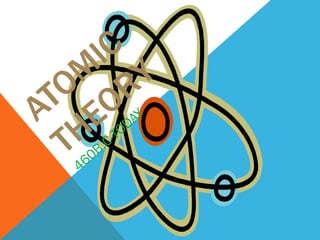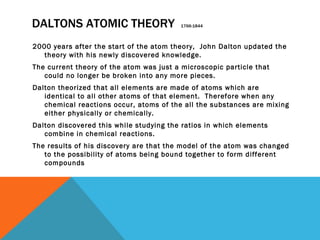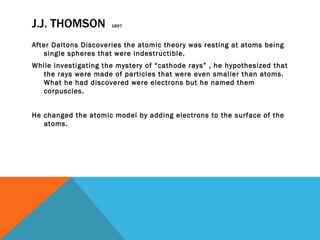Atomic theory
- 2. DEMOCRITUS 460-370 BC Democritus was a Greek philosopher who is credited with the discovery of the atom. He theorized that there must be a particle that can no longer be broken down any further. He proposed the first model of an atom which was just a tiny indestructible and indivisible item. Democritus°Øs discovery was more of an idea than a theory
- 3. DALTONS ATOMIC THEORY 1766-1844 2000 years after the start of the atom theory, John Dalton updated the theory with his newly discovered knowledge. The current theory of the atom was just a microscopic particle that could no longer be broken into any more pieces. Dalton theorized that all elements are made of atoms which are identical to all other atoms of that element. Therefore when any chemical reactions occur, atoms of the all the substances are mixing either physically or chemically. Dalton discovered this while studying the ratios in which elements combine in chemical reactions. The results of his discovery are that the model of the atom was changed to the possibility of atoms being bound together to form different compounds
- 4. J.J. THOMSON 1897 After Daltons Discoveries the atomic theory was resting at atoms being single spheres that were indestructible. While investigating the mystery of °∞cathode rays°± , he hypothesized that the rays were made of particles that were even smaller than atoms. What he had discovered were electrons but he named them corpuscles. He changed the atomic model by adding electrons to the surface of the atoms.
- 5. ERNEST RUTHERFORD 1911 After Thomson discovered electrons, Rutherford added to the discovery of electrons. Rutherford theorized that the middle of an atom is dense and positively charged while smaller negatively charged electrons move around the nucleus. He changed the °∞plum pudding°± idea while shooting an alpha beam through a sheet of gold foil. With some of the beam bouncing off of the foil he discovered that there must be a center to the atom which is dense and solid. In 1912 Rutherford began to study with a fellow scientist by the name of Bohr.
- 6. NIELS BOHR 1913 Teamed up with Rutherford, Bohr updated the atomic theory which said electrons were spinning randomly around the nucleus of the atom. Bohr had discovered in 1913 that the electrons cannot be rotating around the nucleus randomly. He theorized that there must be a set orbit for each electron. When conducting experiments the results were never random, which shows that the electron orbit cannot be random. The new proposed model was similar to how planets orbit the sun changing the way we thought of an atom from then on.
- 7. ERWIN SCHRODINGER 1926-1961 When Schrodinger came along the atomic model was a dense nucleus with electrons orbiting it in set routes. Schrodinger thought of the ways electrons move as a wave. He believed that the electrons created an electron cloud where the probability of finding an electron is greater in the denser areas if the cloud which are typically closer to the nucleus. The model of the atom was changed because instead of set orbits that electrons were displayed as a cloud and were moving incredibly fast.
- 8. JAMES CHADWICK 1932 Rutherford postulated with his theory that there may be the possibility neutrons, or proton/electron pairs. What Chadwick discovered is that there must be neutrons in the nucleus. With the discovery of Beryllium °Æs odd reaction to alpha particles. The radiation produced was extremely penetrating and when passing through a magnetic field they were not deflected.
- 9. ATOMIC THEORY 460-MODERN DAY








